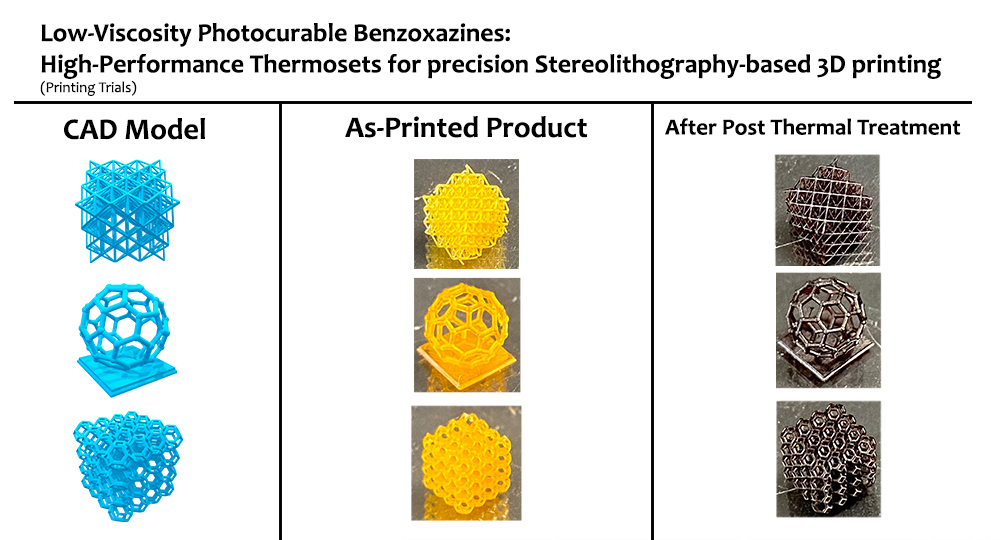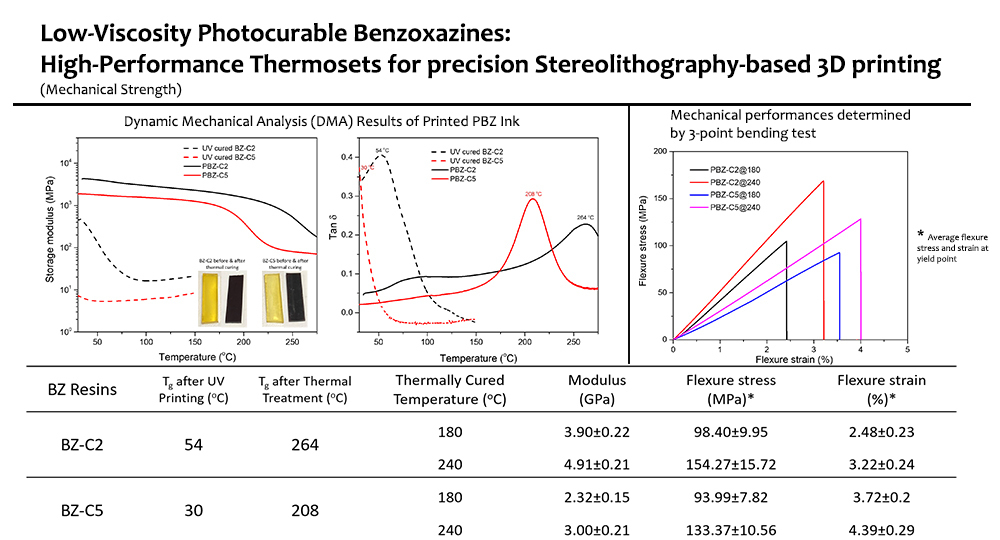Technologies
Discover, Connect & Collaborate at TECHINNOVATION 2021
High-Performance Thermoset Resin for 3D Printing
Technology Overview
Photocurable polybenzoxazine (PBZ) is a newly developed class of high-performance phenolic thermoset with a wide range of unique features, that offer significant advantages over commercially available resins for stereolithography (SLA) or other photo-triggered 3D printing.
- Low viscosity for high precision and high-resolution 3D printing
- Mechanical and thermal performance exceeding commercial resins such as epoxy resin
- Scalable synthesis and production.
Fabrication of engineering products using additive manufacturing (AM) is largely limited to powder-based laser sintering techniques which require expensive equipment and materials, while issues such as voiding and poor surface finishing due to limited resolution remains unresolved. Stereolithography-based AM techniques offers high resolution and void-free products, but current photo-resins does not offer sufficient material performance (e.g., Tg ≤150°C, viscosity ≤5Pa.s) to meet requirements of engineering products.
To address this conundrum, we developed a highly processable BZ (benzoxazine) resin for the mentioned application with spectacular physical properties, thereby offering new possibilities to construct more complicated and intricate structures for demanding engineering applications. Users of our BZ resin can utilise highly affordable SLA printers to meet their diverse engineering product requirements.
We seek partnership with SLA resin manufacturers to expand their products offerings, and also with interested chemical companies to assist in scale-up production and further co-development in this new class of material.
Technology Features, Specifications and Advantages
In this technology, we focused on the additive manufacturing of high-performance materials involving PBZ. We applied our novel molecular design which resulted in low viscosity BZ resins that are favorable for an advance category of 3D-printing known as stereolithography.
Actual printing trials involved projection microstereolithography (PμSL) which was employed to produce high resolution, complex structures using our BZ resins. After progressive post-thermal curing, the as-printed structures were converted to the PBZ structures consequently.
Properties investigation reveals that both PBZs are high-performance thermosets with significantly enhanced transitional temperature (Tg) and mechanical performances. In particular, one of our PBZ printed product exhibits :
- Tg > 260 oC
- Remarkable flexural modulus around 5 GPa
- Flexural strength >150 MPa
This thereby produces a relatively stronger 3D printable material when compared its other conventional 3D printable ink. Also, with the integration of PBZ into the polymer network, the material demonstrates various good properties, exclusive to PBZ, such as :
- near-zero shrinkage
- low water absorption
- high Tg
- intrinsic flame resistance
- high degree of conversion to polymer contributing to good mechanical properties and good thermal properties.
Our findings advance the molecular design of BZ monomers for favourable photopolymerization printing and offers an avenue for efficient fabrication of high-performance thermosets for various desirable engineering applications.
Potential Applications
The primary area of application would be the additive manufacturing/ 3D printing industry/ market which is estimated to be valued at USD 13.78 billion in 2020 and expected to continue to grow. The technology mentioned could be marketed as a BZ printable ink/ resin for the additive manufacturing of high-performance materials.
Specific applications may include :
- Composite Materials
- Coatings
- Adhesives
- Electronics such as printed electronics
- Chemistry and biomedicine such as microfluidics or micro-reactors
- Mechanical parts.
Customer Benefit
- Additive manufacturing generates significantly less waste, thus application of this technology has near zero wastage
- BZ resin developed can adopt very complicated structures with little shrinkage and deformation after post curing
- Structures produced by this material exhibits exceptional physical properties such as thermal stability and mechanical strength.
- Able to be utilized by all sorts of SLA printers thus has no constraints due to equipment specificity.
- Void free after UV and thermal curing.

